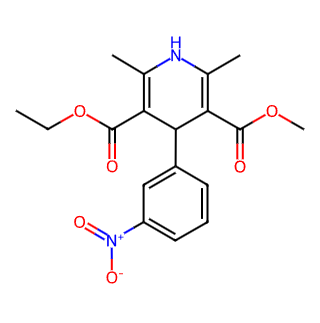- Synthetic anti-infective drugs
- Medications for the digestive system
- Antipyretic and analgesic drugs
- Medications for the blood system
- Medications for the respiratory system
- Anti-allergic drugs
- Medications for the urinary system
- Diagnostic medications
- Immunosuppressive and immunomodulatory drugs
- Vitamins and mineral supplements
- Antioxidants and medications for osteoporosis
- Antiparasitic drugs
- Ophthalmic medications
- Amino acids and their derivatives
- Dermatological medications
- Medications for the circulatory system
- Antitumor drugs
- Medications for the nervous system
- Hormonal and endocrine function-regulating drugs
- Antibiotics
- Others
CAS NO.: 39562-70-4




Nitrendipine
Basic Information
Chinese Name: 尼群地平
English Name: Nitrendipine
Alternative Names: Nifedipine ethylmethyl ester; 2,6-Dimethyl-4-(3-nitrophenyl)-1,4-dihydropyridine-3,5-dicarboxylic acid 1-methylethyl 5-methyl ester
CAS Number: 39562-70-4
EINECS Number: 254-513-1
Molecular Formula: C18H20N2O6
Molecular Weight: 360.36
Physical Properties
Melting Point: Approximately 156-160°C (may vary slightly from different sources)
Boiling Point: Approximately 464.8-492.4°C (may vary under different conditions)
Density: 1.28-1.3595g/cm³
Refractive Index: 1.5700
Solubility: Freely soluble in acetone or chloroform, slightly soluble in methanol or ethanol, practically insoluble in water
Chemical Properties
As an organic compound, Nitrendipine has stable chemical properties but may undergo chemical reactions under specific conditions. The nitro and pyridine ring functional groups in its chemical structure determine its specific chemical properties.
Uses
Research: Nitrendipine is widely used in research fields as an essential raw material for medicinal chemistry, pharmacology, and other studies.
Pharmaceuticals: Nitrendipine is a dihydropyridine calcium channel blocker used primarily in the treatment of hypertension and angina pectoris. It selectively inhibits the transmembrane influx of calcium ions in vascular smooth muscle and myocardium, thereby reducing blood pressure and relieving angina pectoris.
Storage and Transportation
Storage Conditions: Nitrendipine should be stored in a cool, ventilated, dry, and light-protected place to prevent decomposition or deterioration. A recommended storage temperature is 2-8°C.
Transportation Requirements: During transportation, ensure that Nitrendipine is not exposed to high temperatures, humidity, direct sunlight, or other adverse factors to maintain its quality stability.

Tai Yau Street, San Po Kong, Kowloon, Hong Kong, China.



